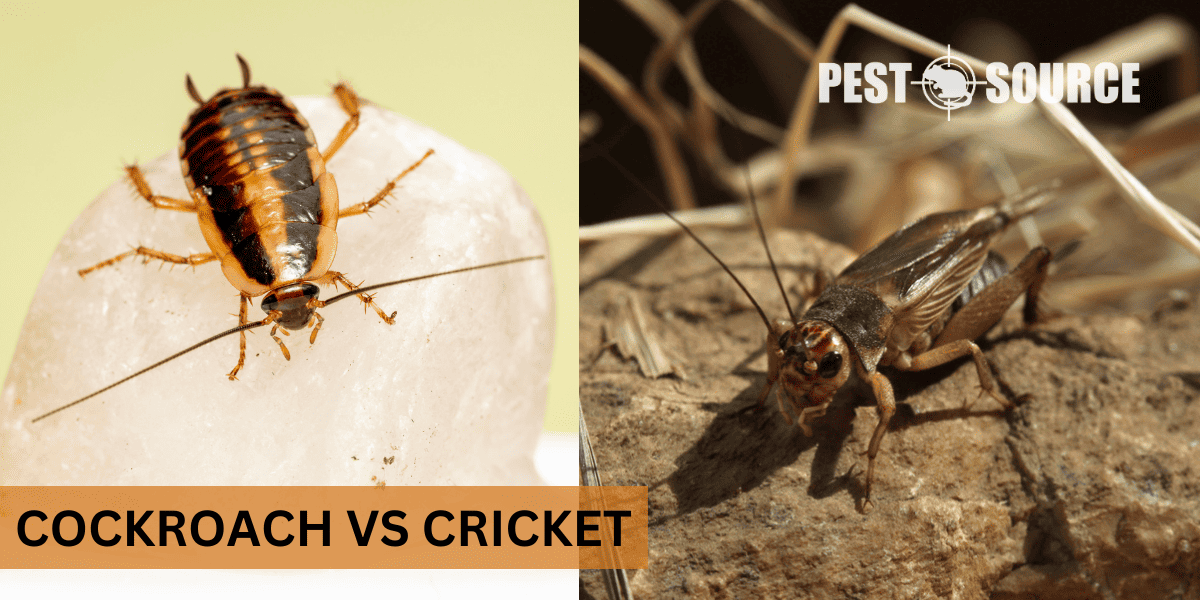Crickets and cockroaches are often confused due to some similarities in appearance, but they have different behaviors and environmental preferences. This comparison will clarify how to distinguish between them and deal with each pest appropriately.
POINTS
- Cockroaches, such as the German cockroach, are typically flat and oval-shaped with a size over an inch long, while house crickets are cylindrical with long hind legs for jumping and are about an inch in length.
- Crickets are known for their chirping, a mating call produced by males, whereas cockroaches do not chirp the same way as crickets do and any noise they make is not used for communication.
- Cockroaches can carry pathogens and exacerbate asthma and allergies, making them a significant pest in human environments, while crickets are less likely to pose health risks but can be a nuisance due to their noise.
- Cockroaches have a longer lifespan and higher reproductive rate compared to crickets, with some species living up to a year and capable of producing hundreds of offspring.
- Effective control measures for cockroaches include maintaining cleanliness and using baits and insecticides, while for crickets, reducing moisture and using traps are recommended, with insecticides as a last resort.
Cockroach vs. Cricket: Physical Characteristics and Identification
When it comes to household pests, the ability to correctly identify the intruder is crucial for effective control. Two common culprits are cockroaches and crickets, which, despite their differences, are sometimes mistaken for one another. Let’s explore how to distinguish these insects through their physical characteristics.
Size, Color, and Body Structure
Cockroaches and crickets differ significantly in size, color, and body structure. Cockroaches, such as the German cockroach, typically have a flat, oval-shaped body, long antennae, and six legs. They range in color from light brown to black and can grow to be over an inch long.

On the other hand, house crickets have a more cylindrical body, also with six legs, but they are distinguished by their long hind legs adapted for jumping. They are usually light brown or tan and can reach about an inch in length.

Identifying Common Species
When identifying these insects, focus on the common species you might encounter. The German cockroach, for example, is a widespread pest known for its preference for warm, humid environments like kitchens and bathrooms. In contrast, the house cricket is often found in warm, damp areas both inside and outside the home.
Misconceptions: “Cricket That Looks Like a Cockroach”
One common misconception is the existence of a “cricket that looks like a cockroach.” This confusion may arise due to the similar brownish coloration and the nocturnal nature of both pests. However, the distinctive chirping sound of crickets and the smoother, less segmented body of cockroaches usually help to differentiate the two.
Behavior, Habitat, and Ecological Roles
Understanding the behavior, habitat preferences, and ecological roles of cockroaches and crickets can further aid in identification and control.
Typical Habitats and Behavioral Differences
Cockroaches are often found in dark, secluded areas of homes and buildings, such as under sinks, behind appliances, and within wall cavities. Crickets prefer similarly dark and moist environments but are also common in outdoor areas with grass and leaf litter.
Adaptations to Urban Environments
Both cockroaches and crickets have adapted well to urban environments. Cockroaches are notorious for their resilience and ability to thrive in various conditions, making them a persistent pest problem. Crickets, while less adaptable than cockroaches, can still be found in urban settings, particularly in yards and basements.
Nocturnal Activities and Social Behaviors
Both insects are primarily nocturnal, which means they are most active at night. Cockroaches tend to be more solitary, while crickets are often heard chirping in groups, especially during mating season.
Dietary Habits
Cockroaches are omnivorous scavengers, known to eat just about anything, which includes paper, fabric, and even glue. Crickets have a plant-based diet, but they can also be omnivorous, feeding on organic materials, including other insects. This brings us to the question: “Do cockroaches eat crickets?” The answer is yes, cockroaches can and will eat crickets if available. Conversely, “Do crickets eat cockroaches?” is less common, but in situations where food is scarce, crickets might consume dead or incapacitated cockroaches.
Sound, Communication, and Misconceptions
The sounds produced by crickets and cockroaches are distinctive and can be a key factor in identifying these insects in your home. Let’s delve into the auditory clues they provide and clarify some common misconceptions.
Why Insects Make Sounds
Crickets are well-known for their chirping, which is primarily a mating call produced by males rubbing their wings together, a process known as stridulation. This sound serves to attract females and can vary in frequency and duration among different cricket species. Cockroaches, however, do not chirp in the same manner.
Cockroaches may produce hissing or clicking sounds, but these are not considered chirping and are not used as a form of communication similar to that of crickets. The sounds cockroaches make are usually the result of their movement, such as when they scurry across a hard surface, when they feel threatened, or in some species, when air is expelled from their breathing pores, known as spiracles. However, these sounds are not used for communication in the way cricket chirps.
Misconceptions: “Do Cockroaches Chirp?”
A common question is, “Do cockroaches chirp?” The answer is no, cockroaches do not chirp like crickets. Any chirping sound in your home at night is more likely to be a cricket than a cockroach. Understanding this can help you determine which pest you might be dealing with.
Interaction with Humans and Public Health Concerns
The presence of cockroaches and crickets in human environments can have different implications for health and well-being. It’s important to understand their impact and how to manage it.
Roles as Pests or Neutral Co-Inhabitants
Cockroaches are generally considered pests due to their potential to spread disease, trigger allergies, and contaminate food. They can carry pathogens on their bodies and in their feces, which can lead to health issues for humans. Crickets, on the other hand, are less likely to be a health hazard, although their incessant chirping can be a nuisance.
Disease Transmission and Allergen Spread
Cockroaches have been associated with the transmission of various diseases such as salmonella, E. coli, and parasitic worms. Their droppings and shed skin can also exacerbate asthma and allergies, especially in children. Crickets are not known to transmit diseases to humans, but like cockroaches, their droppings can contribute to indoor allergens.
Control Measures in Human Environments
Effective control measures are essential to manage the presence of these insects in human environments. For cockroaches, this includes sealing entry points, maintaining cleanliness, and using baits, traps, or insecticides as necessary. For crickets, reducing moisture, sealing cracks, and using cricket traps can help keep their numbers in check.
Lifespan, Reproduction, and Control Methods
Knowing about the lifespan and reproduction of these insects can inform the most effective control methods to prevent infestations.
Lifespan and Reproductive Cycles
Cockroaches have a relatively long lifespan for insects, with some species living up to a year. They reproduce quickly, with females capable of producing hundreds of offspring in their lifetime. Crickets have a shorter lifespan, typically several weeks to a few months, and their reproductive rate is less than that of cockroaches.
Differences in Egg-Laying and Lifecycle Stages
Cockroaches lay eggs in a protective case called an ootheca, which they deposit in hidden locations. Crickets lay their eggs in the soil, and the young, called nymphs, resemble miniature adults. Understanding these differences can aid in locating and eliminating breeding sites.
Natural and Chemical Control Methods
For cockroach control, a combination of sanitation, exclusion, and chemical treatments like baits and sprays can be effective. Natural methods include using boric acid and diatomaceous earth. For crickets, reducing outdoor lighting, which attracts them, and using sticky traps can help. Insecticides can be used as a last resort for persistent problems.
In conclusion, while cockroaches and crickets share some similarities, their differences in physical characteristics, behavior, and impact on human health are significant. By understanding these differences, homeowners can take targeted actions to prevent and control infestations, ensuring a healthier and more comfortable living environment.



